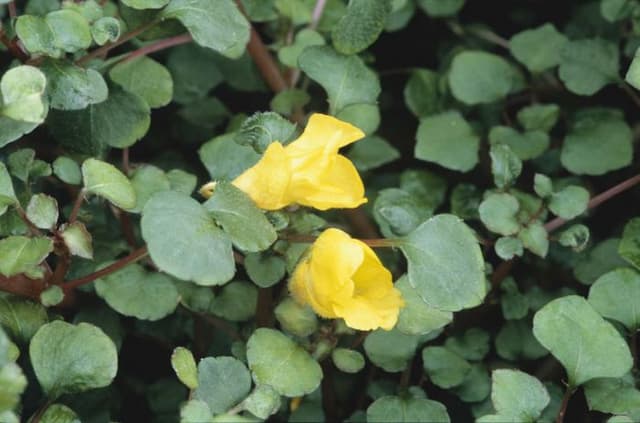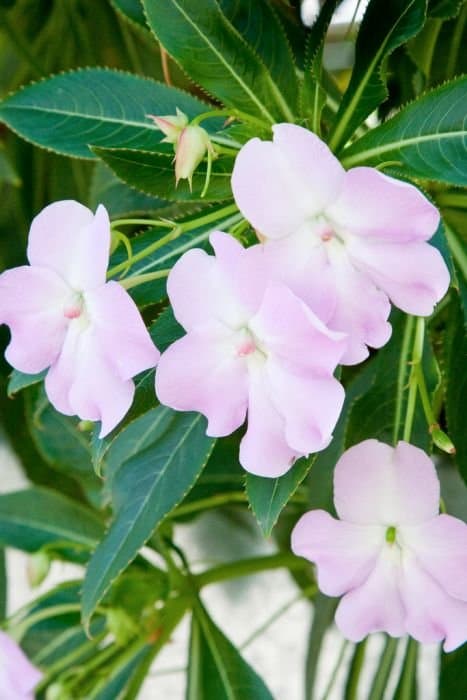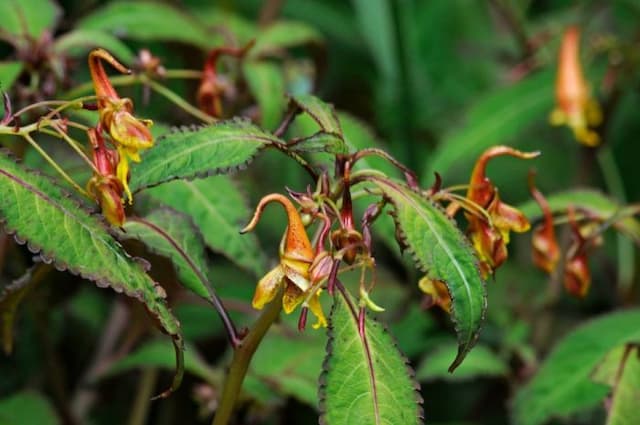Sunpatiens Impatiens Sunpatiens Compact Blush Pink = 'Sakimp013' (PBR) (Sunpatiens Series) (NG)
![busy lizzie [SunPatiens Compact Blush Pink]](/_next/image?url=https%3A%2F%2Fplants-admin.emdemapps.com%2Fimages%2Fplants%2F%2Fimages%2F604b64a6f0b6f.png&w=3840&q=75)
ABOUT
The Impatiens Sunpatiens Compact Blush Pink is a striking and vibrant ornamental plant that stands out for its lush foliage and beautiful flowers. The leaves are glossy, rich green, and have a robust, dense growth habit. This sturdy plant is known for its compact nature, meaning it forms a well-structured appearance, perfect for garden beds or containers. The most charming aspect of the Impatiens Sunpatiens Compact Blush Pink is its flowers. They bloom prolifically and are characterized by a soft, blush pink color that has a subtle gradation of hues. The blossoms are round, resembling a classic impatiens shape, with a slightly more open face, allowing viewers to see into the heart of the flower, where the subtle deeper tones and delicate patterns can be seen. Each flower is composed of five slightly overlapping petals that create a harmonious circular form. The center of the flower often features a small, distinctive cluster of stamens which add a touch of contrasting color and interest. The overall effect of the blooms is one of gentle and soothing color, which can complement a variety of garden settings and color schemes. Moreover, the Impatiens Sunpatiens Compact Blush Pink is notable for its continuous flowering habit. It can provide a long season of color, with flowers often appearing in abundance from the late spring until the first frost of fall. This attribute makes it a favorite among gardeners looking for long-lasting visual interest in their outdoor spaces.
About this plant
 Names
NamesSynonyms
Sunpatiens, Compact Blush Pink Impatiens, New Guinea Impatiens.
Common names
Impatiens hawkeri 'Sakimp013'
 Toxicity
ToxicityTo humans
The plant commonly known as Sunpatiens is not considered toxic to humans. There are no well-documented cases of poisoning from ingesting the plant, and it is generally regarded as safe. However, it is always advisable to avoid eating ornamental plants as a precaution.
To pets
Sunpatiens is also not known to be toxic to pets. It is generally considered safe for dogs, cats, and other domestic animals. As with humans, it's prudent to prevent pets from ingesting plants not meant for consumption, as they might cause digestive upset even if they aren't poisonous.
 Characteristics
CharacteristicsLife cycle
Annuals
Foliage type
Evergreen
Color of leaves
Green
Flower color
Pink
Height
1-2 feet (30-60 cm)
Spread
1-2 feet (30-60 cm)
Plant type
Herb
Hardiness zones
10
Native area
Asia
Benefits
 General Benefits
General Benefits- Highly versatile – Thrives in both full sun and partial shade, adapting well to various lighting conditions.
- Continuous blooming – Produces a profusion of blush pink flowers that bloom from spring to the first frost, providing long-lasting color in the garden.
- Disease-resistant – Offers strong resistance to common diseases like downy mildew, which can affect other impatiens varieties.
- Easy to care for – Requires minimal maintenance, making it suitable for both experienced and novice gardeners.
- Heat-tolerant – Able to withstand higher temperatures, making it a good choice for warmer climates.
- Compact growth habit – Has a neat, mounded growth that makes it ideal for containers, hanging baskets, and small garden spaces.
- Attracts pollinators – Invites hummingbirds and butterflies, adding more life and movement to your garden.
 Medical Properties
Medical PropertiesThis plant is not used for medical purposes.
 Air-purifying Qualities
Air-purifying QualitiesThis plant is not specifically known for air purifying qualities.
 Other Uses
Other Uses- Sunpatiens can be used as a colorful natural dye for fabrics, providing a soft pastel hue to natural fibers.
- Pressed flower art can include the petals of Sunpatiens, adding a delicate blush to bookmarks, greeting cards, or framed botanical collages.
- Edging for garden paths or borders can be created with the compact variety, helping to define walkways and garden beds pleasantly.
- As a temporary ground cover, Sunpatiens provide a quick way to fill in bare spots in the garden while permanent plants establish.
- Biodegradable confetti can be made from the dried petals of Sunpatiens, suitable for outdoor celebrations with an eco-friendly twist.
- Due to their relatively thick foliage, Sunpatiens can be used in living wreaths or as a base in floral design for events.
- Photography enthusiasts sometimes use colorful plants like Sunpatiens as soft, natural backdrops for macro photography.
- As an educational tool, growing Sunpatiens can help teach children about plant lifecycle, pollination, and basic horticulture practices.
- Empty planters or spaces in the landscape can quickly be beautified by planting Sunpatiens to add instant color and volume.
- Culinary presentations can be enhanced by using the non-toxic flowers of Sunpatiens as vibrant, edible garnishes for dishes and drinks.
Interesting Facts
 Feng Shui
Feng ShuiImpatiens are not commonly associated with Feng Shui practice.
 Zodiac Sign Compitability
Zodiac Sign CompitabilityImpatiens are not used in astrology practice.
 Plant Symbolism
Plant Symbolism- Impatience: As the name suggests, impatiens can symbolize a restless or eager personality, reflecting the plant's common name and its botanical characteristics, as it quickly grows and blooms.
- Patiently Waiting: Conversely, it can also symbolize patience and the ability to stay positive and wait for good things to come, playing on the irony of its name, and reminding us that good things come with time.
- Affection: Its delicate and appealing bloom can represent a tender and gentle affection towards someone.
- Transient Nature: Like many flowers, impatiens can symbolize the fleeting nature of life, as many species have short-lived blooms, reminding us to enjoy the present.
 Water
WaterSunpatiens should be watered regularly to keep the soil consistently moist but not waterlogged. During hot or dry periods, watering may be necessary every day, while in cooler or overcast conditions less frequent watering is needed, perhaps every two to three days. Water the plants deeply with approximately 16 ounces for smaller pots or up to 1 gallon for larger containers, adjusting based on the plant size and environmental conditions. Be cautious of watering directly on the leaves to prevent disease; instead, water at the base of the plant.
 Light
LightSunpatiens flourish in bright to partial sunlight but can also tolerate high temperatures and full sun conditions. To ensure vibrant blooms and healthy growth, position the plant in a spot where it will receive at least 4 to 6 hours of sunlight daily. Avoid locations with prolonged shade as it can result in leggy growth and fewer flowers.
 Temperature
TemperatureSunpatiens are heat tolerant and grow best in temperatures that range between 60°F and 85°F. They can withstand minimum temperatures down to about 32°F, but frost can be damaging or fatal. Optimal growth and flowering occur when nighttime temperatures are above 45°F and daytime temperatures do not exceed 90°F.
 Pruning
PruningPruning Sunpatiens promotes a bushier growth habit and encourages more blooms. Trim back leggy stems and spent flowers regularly to maintain the plant's shape and size. The best time for heavier pruning is in the spring before the new growth begins, but light pruning and deadheading can be done throughout the growing season as needed.
 Cleaning
CleaningAs needed
 Soil
SoilSunPatiens prefer well-draining soil with a good amount of organic matter. A mix containing peat moss, perlite, and garden loam is ideal. Aim for a pH range between 5.8 and 6.5 for optimal growth.
 Repotting
RepottingSunPatiens should typically be repotted every 12 to 18 months. They can become root-bound fairly quickly due to their rapid growth, so regular repotting helps maintain their health.
 Humidity & Misting
Humidity & MistingSunPatiens thrive best in moderate to high humidity levels, around 40-70%. They are somewhat tolerant of lower humidity environments but will do best when the air isn't too dry.
 Suitable locations
Suitable locationsIndoor
Place in bright, indirect light with ample airflow.
Outdoor
Plant in partial shade, water regularly, protect from frost.
Hardiness zone
10-11 USDA
 Life cycle
Life cycleThe life cycle of the Impatiens SunPatiens Compact Blush Pink begins with the germination of seeds, which require warm temperatures and consistent moisture to sprout. Seedlings emerge and begin to establish a rudimentary root system, followed by the development of foliage. As the plant matures, it enters a vegetative growth stage, producing robust greenery and branching stems that set the foundation for future flowering. The plant proceeds to the flowering stage, where it produces its characteristic blush pink blossoms, attracting pollinators and sometimes setting seed if conditions permit. After the flowering period, if seeds are produced, they will mature and eventually be dispersed, completing the cycle. Over time or under unfavorable conditions, the plant will reach senescence, where growth slows and the plant eventually dies, although in cultivation, they are often treated as annuals and replaced each season.
 Propogation
PropogationPropogation time
Spring-Early Summer
Propogation: The most popular method for propagating Impatiens SunPatiens Compact Blush Pink is through cuttings. This process typically begins by selecting healthy, non-flowering shoots from the parent plant during the active growing season, which for this variety is typically spring to early summer. A sharp, sanitized pair of scissors or a knife is used to take a cutting of about 3-4 inches (approximately 7.5-10 centimeters) long, ensuring at least two sets of leaves are present. The lower leaves are removed, and the cut end is dipped into a rooting hormone to facilitate root development. The cutting is then placed into a moist potting mix, and the environment is kept humid by covering with a plastic bag or placing in a propagator. The cuttings will usually root within a few weeks, after which they can be transferred to individual pots to grow on before being planted out.
![Busy lizzie [Sun Harmony Deep Orange]](/_next/image?url=https%3A%2F%2Fplants-admin.emdemapps.com%2Fimages%2Fplants%2F%2Fimages%2F604b57b5f28cb.png&w=640&q=75)
![Busy lizzie [Divine Violet]](/_next/image?url=https%3A%2F%2Fplants-admin.emdemapps.com%2Fimages%2Fplants%2F%2Fimages%2F604b651b90e59.png&w=640&q=75)




![Busy lizzie [SunPatiens Compact Orange]](/_next/image?url=https%3A%2F%2Fplants-admin.emdemapps.com%2Fimages%2Fplants%2F%2Fimages%2F604b5ef883e70.png&w=640&q=75)
![Busy lizzie [SunPatiens Vigorous Magenta]](/_next/image?url=https%3A%2F%2Fplants-admin.emdemapps.com%2Fimages%2Fplants%2F%2Fimages%2F604b622adf631.png&w=640&q=75)

